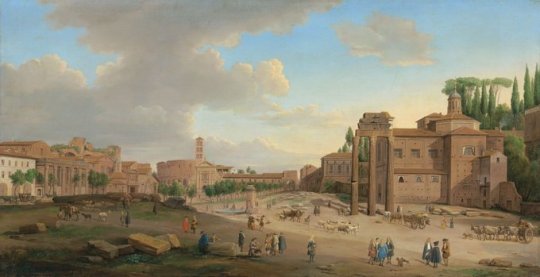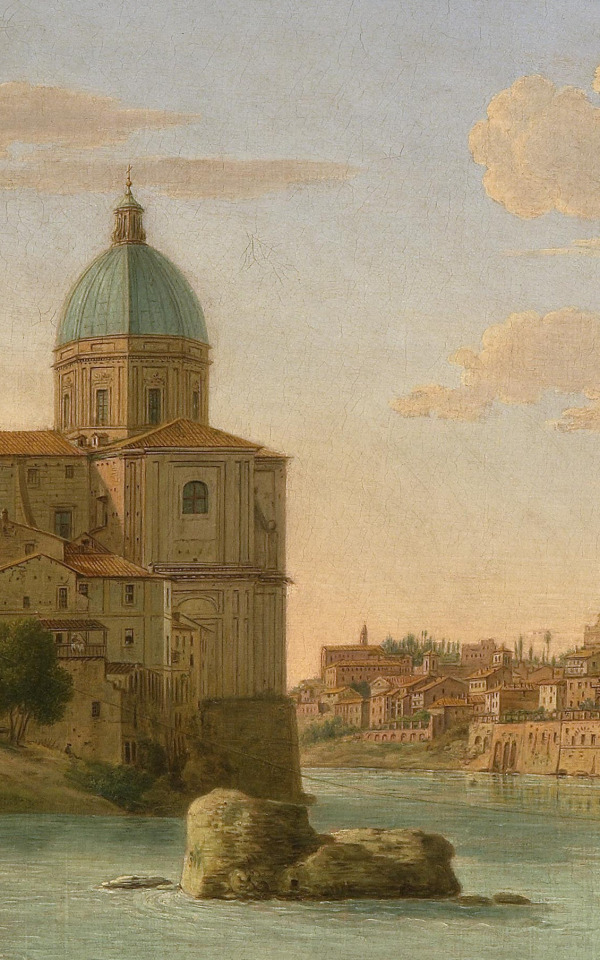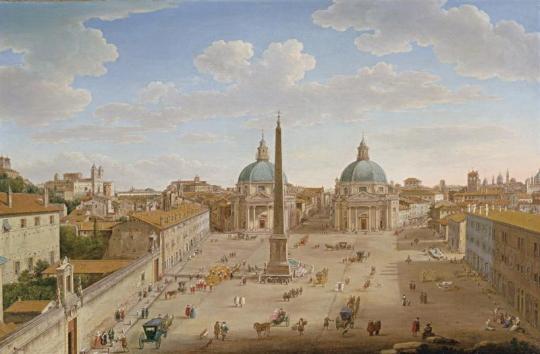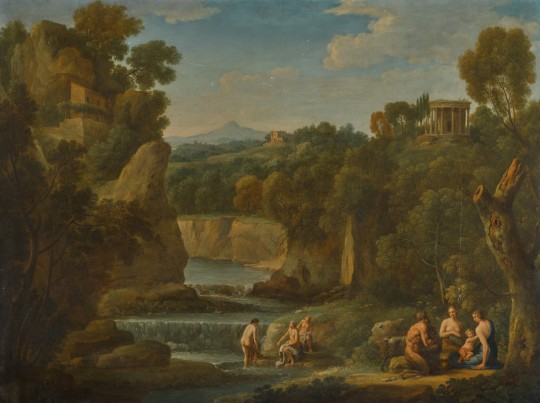#Hendrik Frans van Lint
Explore tagged Tumblr posts
Text



The Picture Gallery, the Sciences and the Arts, oil on an oak panel, by A. van Stalbemt.
In a vast interior, scholars and connoisseurs contemplate and discuss paintings, engravings, and portraits on vellum, sculptures, scientific objects and curiosities. A wide variety of pictorial genres are represented in the paintings: landscapes, still lifes, historical pieces, portraits, altarpieces, religious scenes and allegories. With this work, Adriaen van Stalbemt pays tribute to the richness of both contemporary Flemish painting and that of past centuries. On the left, hanging from the large piece of carved wooden furniture through which it was possible to access this room, is a work of the interior of a church as Pieter Neefs the Elder (with whom Adriaen van Stalbemt may have worked) would have depicted it, while above it is possible to recognise, through the Italianate landscape inspired by the Roman forum, the work of a member of the famous Bentveughels community, made up of Flemish and Dutch artists active in Rome in the early 17th century such as Bartholomeus Breenbergh, Jan Asselijn, Hendrik Frans van Lint and Willem van Nieulandt. The bluish tondo landscape is possibly by the hand of Paul Bril.
On the lower right, the painting showing game on an entablature covered in red drapery is undoubtedly by Pieter Snijders (the deer strung up in the foreground is a recurring motif in the master's work, as are the lobster and the basket garnished with bunches of white and red grapes) (1).
The work placed on a red armchair with a young man leaning over it in the foreground is inspired by The Abundance and the Four Elements painted by Hendrick van Balen in collaboration with Jan Brueghel the Elder (now in Madrid, Prado Museum, P001399, fig. 1), while the landscape placed on the floor against the foot of the chair evokes the work of Jaspar van der Laanen, Alexander Keirinx and Jan Brueghel the Younger. Among the paintings on the back wall, the Saint Jerome recalls the work of sixteenth-century Flemish painters Joos van Cleve, Pieter Coecke van Alst and Marinus van Reymerswaele, whose study of the saint depicted as a cardinal is a favourite subject, while the landscape to his left is probably by Joos de Momper. The large bacchanal in the centre is reminiscent of the work of Hendrick van Balen, while the scene depicting the Queen of Sheba before King Solomon is probably by Frans Francken II.
Finally, the portrait of the hunter holding the head of a fox is known from a painting in Karlsruhe attributed to the entourage of Karel Dujardin (no. 302) (2). Two men contemplate a curved altarpiece depicting the Virgin crowned by angels on a green background by Adriaen Isenbrant (now in the Gemäldegalerie in Berlin (inv. 554), fig. 2), while the Holy Family surrounded by a wreath of flowers is probably a work by Frans Francken II or Jan Brueghel II in collaboration with Daniel Seghers.
Born in Antwerp and of Protestant faith, Adriaen Stalbemt took refuge in Middelburg between 1585 and 1609 due to the political unrest that engulfed the city of Antwerp in the 1580s. He returned to his hometown in 1609, probably after the proclamation of the Twelve Years' Truce, where he became master of the Guild of Saint Luke and then dean between 1618 and 1619. He participated in the intellectual life of the city through his membership in the chamber of rhetoric known as De Violeren. After a brief stay in England between 1632 and 1633, during which he produced a View of Greenwich with Charles I and Henrietta Maria (Royal Collection, Hampton Court, London) and collaborated with his compatriot Jan van Belkamp, he returned to Antwerp, where he died in 1662. Well-established in the thriving Antwerp market at the beginning of the 17th century, he produced paintings for the merchant Chrysostomus van Immerseel between 1634 and 1641. Establishing a precise chronology of his production remains a challenge, since his paintings are rarely dated (3). A specialist in paintings that were intended for display in these picture cabinets, Stalbemt produced a variety of works over the course of his long career, ranging from landscapes to depictions of cabinet interiors. His religious, mythological and allegorical scenes are often set in elaborate landscapes, a genre in which he excelled. The Triumph of David over Goliath in the Prado Museum (Madrid) painted in concert with Jan Brueghel the Younger shows that he collaborated with other Antwerp artists as a figure painter (no. P001782).
In the 1610s and 1620s, Frans Francken the Younger and Jan Brueghel I were the first to paint this type of subject. As an example, one could look at the cabinet of curiosities painted by Frans Francken II from 1619, kept at the Royal Museum of Fine Arts in Antwerp (inv. 816, fig. 3). Ursula Härting has shown that Frans Francken II produced these subjects before 1617, a milestone previously established as the year of the introduction of this genre by means of Jan Brueghel the Elder’s The Sense of Sight from 1617 (Prado Museum, Madrid, no. P001394, fig. 4). It is therefore in the wake of the production of Frans Francken II, who, with the help of a large workshop, produced numerous variants after a first prototype, that our work should be placed. Our painting is similar to another work by Stalbemt in the Prado Museum (inv. P001405, fig. 5) of which other versions are known, one having being with the De Jonckheere gallery in 2002 and the other appearing in a sale in Zurich (4). There are other interieur scenes that depict galleries of paintings of this painter.
Artcurial
10 notes
·
View notes
Text

Hendrik Frans van Lint - Rome, with a view of San Giovanni dei Fiorentini (1739). Details
2 notes
·
View notes
Photo

Hendrik Frans Van Lint: Vistas do Foro de Roma (1735)
4 notes
·
View notes
Photo


Rome, A View of San Giovanni dei Fiorentini (detail), c. 1739. Hendrik Frans van Lint
#Rome A View of San Giovanni dei Fiorentini#art#Hendrik Frans van Lint#Flemish artist#veduta#Artedit#Architecture#rome#Italy#art detail
721 notes
·
View notes
Photo

Hendrik Frans van Lint - Roma - Piazza del Popolo - 1750
Piazza del Popolo is a large urban square in Rome. The name in modern Italian literally means "People's Square", but historically it derives from the poplars (populus in Latin, pioppo in Italian) after which the church of Santa Maria del Popolo, in the northeast corner of the piazza, takes its name.
The piazza lies inside the northern gate in the Aurelian Walls, once the Porta Flaminia of ancient Rome, and now called the Porta del Popolo. This was the starting point of the Via Flaminia, the road to Ariminum (modern-day Rimini) and the most important route to the north. At the same time, before the age of railroads, it was the traveller's first view of Rome upon arrival. For centuries, the Piazza del Popolo was a place for public executions, the last of which took place in 1826.
Hendrik Frans van Lint (1684 – 24 September 1763) was a Flemish landscape and vedute painter who was part of the group of Flemish and Dutch painters active in Rome. He was one of the leading landscape painters in Rome in the first half of the 18th century and his patrons included Rome's old aristocratic families as well as European travellers on their Grand Tour.
35 notes
·
View notes
Photo

Italianate Pastoral Landscape with Capriccio Ruins, Hendrik Frans van Lint (1684-1763)
#art#art history#Hendrik Frans van Lint#landscape#landscape painting#pastoral#Italianate#ruins#capriccio#veduta#vedutismo#vedutisti#Flemish art#18th century art
132 notes
·
View notes
Photo

Hendrik Frans van Lint, 1684-1763
A wooded arcadian landscape with a Satyr and Nymphs, with a distant view to the Temple of Vesta at Tivoli, 1736, oil on canvas, 49x64.5 cm
Private Collection
3 notes
·
View notes
Photo

Hendrik Frans van Lint
A CAPRICCIO LANDSCAPE WITH THE VILLA DORIA PAMPHILI IN THE DISTANCE
14 notes
·
View notes
Text

veduta of la salute with the punta della dogana, Hendrik Frans van Lint (1750)
0 notes
Text

Hendrik Frans van Lint - Rome, with a view of San Giovanni dei Fiorentini (1739). Details
1 note
·
View note
Text
4. SEMPER FIDELIS
Er spookt weer van alles door mijn hoofd… De Gouden Eeuw, de collaboratievlag, het klimaat…. En als dat het geval is dan moet ik eens alles op orde zetten. Ongetwijfeld wordt het een verhaal in vele stukjes. De rode draad : de Vlaamse canon. Soms weggelachen met de zin “ ‘t zijn weiden als wiegende zeeën”.
1. Semper fidelis
2. Ik weet nog hoe het was
3. Het einde der tijden? Eschatologie, apocalyps en schuldgevoel
4. Hoe opvoeden?
Zoals velen weten wappert bij mij altijd de leeuwenvlag. Een geel veld met een zwarte leeuw uiteraard. Sommigen noemen dat nu de collaboratievlag. Anderen lachen wel eens omdat ik dat doe. Wees gerust, de vlag hangt er het ganse jaar, ik heb er al een nieuwe besteld voor volgend jaar ergens in mei. “This land is my land” denk ik soms. Waarom? Dat is een heel verhaal.
Vijftien september 2019: kermis in Alveringem. Zoals gewoonlijk veel volk, kermisattracties oude tractoren of reenactors of…. Vandaag : motoren. Veel merkwaardig volk in ’t leer, heel veel tattoos en ook wel gothics. Ik ontvlucht even de drukte en ga wandelen op het mooie kerkhof. Ik ben er helemaal alleen. Plots sta ik voor het graf van de kapelaan van operatie Brevier (VMO), Cyriel Verschaeve. In gedachten spreek ik hem toe “Cyriel je ligt hier goed jongen, zo onder een stevig stuk beton, blijf nu maar liggen”. Op zijn graf liggen er drie verdorde kransen : één van Schild en Vriend, één van de Ijzerwake (Steenstraete) en één van ? Ik bekijk die laatste krans en er valt een zwart-geel lint op de grond en daarop staat “Semper fidelis”. Ik stop het lint, er is niemand te zien, in mijn zak, het siert nu mijn toetsenbord. Ik onderzoek het : semper fidelis is blijkbaar de spreuk van het NSV.
Semper fidelis, dàt is het helemaal! Eeuwige trouw. Dit is mijn land, ’t was altijd zo, ook nu en hopelijk voor altijd. Hier ben ik thuis. Dit is geen imperialisme of een soort bekrompen nationalisme. Het is gewoon “hier hoor ik thuis” en niemand moet dat veranderen. Want veranderen : dat kan! Ik ken onze recente geschiedenis.
Bellegem grenst aan Dottenijs, tot 1964 was dit Vlaanderen. Moeskroen en Luigne (spreek uit “Loendje”) ook. Tot voor de tweede wereldoorlog zei men niet Marke maar Marcke-Lez-Lys en ik heb de inmiddels overleden onderwijzers nog gekend die ervoor gezorgd hebben dat Aalbeke Vlaams gebleven is.
’t Is misschien romantisch maar vroeger reed ik veel met de fiets tussen Kassel, Sint-Winoksbergen en Duinkerke. Allemaal verloren land. Onlangs was ik nog in Burburg, een prachtige streek dicht bij de zee, Ik verkende er “Le Puythouck”. En zo passeerde ik ook twee cafés : “Le Praetelaere” en “Le Kouckestuute”.
En als wij naar Brussel rijden dan doen wij dit via de Hennuyère, een mooie autostrade op de taalgrens. Edingen , Lettelingen, Hove…. Allemaal het Waals gewest nu met faciliteiten die systematisch geboycot worden. Het Vlaams verdwijnt hier zeer snel.
En een laatste voorbeeld heel wat verder: Aubel, Hendrik-Kapelle, Sippenaken en de dorpen van Overmaas��� In Aubel zaten wij ooit op restaurant naast 4 bejaarde autochtonen. Ik kon hun Limburgs dialect probleemloos volgen net zoals je dat kan tot in Kelmis, Plontzen en Lontzen. Allemaal slachtoffers van het Waals en Frans imperialisme. Wij zijn nogal wat kwijtgeraakt en daarom zeg ik “’t is genoeg geweest”.
Er is nog iets : Thuis spreken wij Westvlaams. Ik moet bekennen dat wij al veel kwijt zijn. Zeg niet “lente of herfst” maar zoals ik “n’uutkom en ’t achterjaar”. Ik zeg ook wel eens “een buurmeisje trouwt en we zijn gevraagd voor ’t beschienk.” Of nog straffer: “Hanne die enkele huizen verder woont is bevallen van een dubbelzaad”. Maar eigenlijk is dat al een beetje gekunsteld. Veerle komt uit Bachten de Kupe en zegt nog wel eens “we gaan de kosjie moeten steperen met de ruuscher” (den trottoir vegen met de harde borstel). Of “je gaat de keuns moeten strievelen” maar ook dat zit al ver. Haar ouders en een schoonzus en schoonbroer die al tientallen jaren vlak op de Franse grens wonen dat zijn echte native speakers waar ik toch jaloers op ben. “è lietje bei’n ” zeggen ze tegen een kleinkind (wacht eens een beetje) en nog heel veel meer. De mikke en een stuutje butteren De maandag na kermiszondag is er kandeel. En hun taal zit vol “ingweonismen (taalverschijnselen): kats en rats, aons, kieks , keuns en mols, zwiens en uuls. En wijze spreuken als “de schurse groeit nao den boom” (dat koppel begint op elkaar te lijken).
Mijn kinderen spreken ook nog ons dialect maar het is al een soort tussentaaltje. Zelfs Stéphanie, mijn jongste schoondochter, geboren en getogen in Moeskroen spreekt Vlaams en ik hoor haar zeggen “mijn broer is garagist en zijn wuuf zit up de mutuelle”. In Marke en Aalbeke zijn er twee rusthuizen : de Ruysschaert en de Weister. Geen één van mijn kinderen weet dat een ruysschaert een oude perensoort is en weister “Ruimte “ betekent. Een bijna honderdjarige buurman zei ooit “’k heb geren een beetje weister”. Ze weten ook niet dat er van onze 8 kleinkinderen zes “eigenrechtsweerds “ zijn en ook twee “gebroken rechtsweerds “(die van mijn dochter).
Alle kleinkinderen spreken vooral algemeen Nederlands, en straks als ze naar de middelbare school gaan misschien een soort algemeen gekuist westvlaams. En in een nog verdere toekomst spreken de achterkleinkinderen allicht verkamelingsvlaams. Misschien zegt een kleindochter later : opa van Bellegem zei eens in de winter tegen mij “je zie geklid lijk ne rauw’n andjoen”? Ja zei d’ander, en na een barbecue zei die altijd “ ‘k zien dikke lik nen ‘oed’n oend”.
Kort samengevat: nuze grond, nuus huus, nuze sprake. En de kerk in ‘ t midden. Semper Fidelis. Oppassen voor die Vlamingen die dwepen met de eurometropool. Zij dienen de verfransing! Oppassen ook voor de verengelsing van ‘t onderwijs. En als ik hoor dat volgens sommigen de allochtone kinderen in Gent in de lagere school les moeten krijgen in het Turks of Syrisch enzovoort om beter te integreren dan verklaar ik hen helemaal gek!
0 notes
Photo

Rome, A View of San Giovanni dei Fiorentini, c. 1739. Hendrik Frans van Lint
#Art#A View of San Giovanni dei Fiorentini#Hendrik Frans van Lint#Dutch artist#veduta#architecture#artedit#Rome#Italy
120 notes
·
View notes
Photo

Hendrik Frans van Lint - A Landscape with the Nurture of Jupiter - 1737
Hendrik Frans van Lint (1684 – 24 September 1763) was a Flemish landscape and vedute painter who was part of the group of Flemish and Dutch painters active in Rome. He was one of the leading landscape painters in Rome in the first half of the 18th century and his patrons included Rome's old aristocratic families as well as European travellers on their Grand Tour.
His idealized landscapes follow less the style of his contemporaries and compatriots Abraham Genoels and Jan Frans van Bloemen, who specialized in this subject matter. Van Lint went in a different direction under the influence of Claude Lorrain's Arcadian landscapes. Van Lint may have studied Lorrain's works in numerous Roman collections. It has been suggested that van Lint started out as a reluctant copyist of the work of Lorrain whose work was in strong demand but unavailable on the market. It was only later that he started to paint his own compositions inspired by and dotted with references to Lorrain as well as Nicolas Poussin.
A good example of the influence of Lorraine on his idealized landscapes are the pair of paintings entitled Landscape with a Watermill and Dancing Figures (The Wedding of Isaac and Rebecca) and Landscape with the Nurture of Jupiter (private collections). The two compositions are directly inspired by Lorrain's monumental pair of landscapes in the Galleria Doria Pamphilij, Rome. In particular the first work is directly based on Lorrain's Landscape with Dancing Figures (The Mill), while the second is only inspired in its overall design by Claude's original of the View of Delphi with a procession. Van Lint was no slavish follower of Lorrain but rather an inventor of his own as shown by the fact that he introduced a number of elements that are absent from Claude's work, such as the hound in the centre or the shepherd leading his flock over a bridge. Van Lint also shows that he is at heart a vedute painter who preferred realistic views by substituting for Claude's fantastical domed palace a representation of the Colosseum and a monument that he had depicted on numerous occasions in his Roman vedute and may be based on an existing feature in Rome. Like Lorrain, van Lint paid particular attention to the trees in his compositions. His wide open compositions are imbued with silence and invite contemplation. It has been argued that van Lint adapted Lorrain's style to 18th-century taste by using paler and clearer tones, prettier colours and sharper handling.
28 notes
·
View notes











